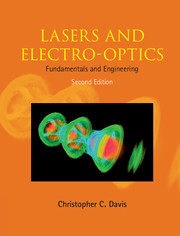Book contents
- Frontmatter
- Contents
- Preface to the Second Edition
- 1 Electromagnetic waves, light, and lasers
- 2 Optical frequency amplifiers
- 3 An introduction to two practical laser systems
- 4 Optical resonators containing amplifying media
- 5 Laser radiation
- 6 Control of laser oscillators
- 7 Optically pumped solid-state lasers
- 8 Gas lasers
- 9 Molecular gas lasers I
- 10 Molecular gas lasers II
- 11 Tunable lasers
- 12 Semiconductor lasers
- 13 Passive optical systems
- 14 Periodic optical systems, resonators, and inhomogeneous media
- 15 The optics of Gaussian beams
- 16 Optical fibers and waveguides
- 17 The optics of anisotropic media
- 18 The electro-optic and acousto-optic effects and modulation of light beams
- 19 Introduction to nonlinear processes
- 20 Wave propagation in nonlinear media
- 21 Detection of optical radiation
- 22 Coherence theory
- 23 Laser applications
- Appendix 1 Optical terminology
- Appendix 2 The ´-function
- Appendix 3 Black-body radiation formulas
- Appendix 4 RLC circuits
- Appendix 5 Storage and transport of energy by electromagnetic fields
- Appendix 6 The reflection and refraction of a plane electromagnetic wave at a boundary between two isotropicmedia of different refractive indices
- Appendix 7 The vector differential equation for light rays
- Appendix 8 Symmetry properties of crystals and the 32 crystal classes
- Appendix 9 Tensors
- Appendix 10 Bessel-function relations
- Appendix 11 Green's functions
- Appendix 12 Recommended values of some physical constants
- Index
- References
7 - Optically pumped solid-state lasers
Published online by Cambridge University Press: 05 June 2014
- Frontmatter
- Contents
- Preface to the Second Edition
- 1 Electromagnetic waves, light, and lasers
- 2 Optical frequency amplifiers
- 3 An introduction to two practical laser systems
- 4 Optical resonators containing amplifying media
- 5 Laser radiation
- 6 Control of laser oscillators
- 7 Optically pumped solid-state lasers
- 8 Gas lasers
- 9 Molecular gas lasers I
- 10 Molecular gas lasers II
- 11 Tunable lasers
- 12 Semiconductor lasers
- 13 Passive optical systems
- 14 Periodic optical systems, resonators, and inhomogeneous media
- 15 The optics of Gaussian beams
- 16 Optical fibers and waveguides
- 17 The optics of anisotropic media
- 18 The electro-optic and acousto-optic effects and modulation of light beams
- 19 Introduction to nonlinear processes
- 20 Wave propagation in nonlinear media
- 21 Detection of optical radiation
- 22 Coherence theory
- 23 Laser applications
- Appendix 1 Optical terminology
- Appendix 2 The ´-function
- Appendix 3 Black-body radiation formulas
- Appendix 4 RLC circuits
- Appendix 5 Storage and transport of energy by electromagnetic fields
- Appendix 6 The reflection and refraction of a plane electromagnetic wave at a boundary between two isotropicmedia of different refractive indices
- Appendix 7 The vector differential equation for light rays
- Appendix 8 Symmetry properties of crystals and the 32 crystal classes
- Appendix 9 Tensors
- Appendix 10 Bessel-function relations
- Appendix 11 Green's functions
- Appendix 12 Recommended values of some physical constants
- Index
- References
Summary
Introduction
In this chapter we shall discuss in some detail the operating principles, characteristics, and design features of solid-state lasers in which the laser medium is an insulating or glassy solid. In many of these lasers the active particles are impurity ions doped into a host matrix. These lasers are pumped optically, with a pulsed or continuous lamp, and most commonly by another laser. Our discussion will build on the brief introduction to one laser of this class, namely the ruby laser, given in Chapter 3. The chapter will conclude with a discussion of the characteristics of the radiation emitted by such lasers and how this radiation can be modified and controlled in time.
Optical pumping in three- and four-level lasers
Optical pumping in an insulating solid-state laser is illustrated schematically in Fig. 7.1. Light from the pumping lamp(s) excites ground-state particles into an absorption band, labeled 3 in the figure. Ideally, particles that reach this state should transfer rapidly into the upper laser level, level 2. If transfer occurs preferentially to level 2 rather than to level 1, a population inversion will result between levels 2 and 1, and laser action can be obtained. The drain transition from level 1 back to the ground state should be fast, in order to keep level 1 from becoming a “bottleneck.” The performance of the laser will be influenced by several factors.
- Type
- Chapter
- Information
- Lasers and Electro-opticsFundamentals and Engineering, pp. 153 - 205Publisher: Cambridge University PressPrint publication year: 2014



